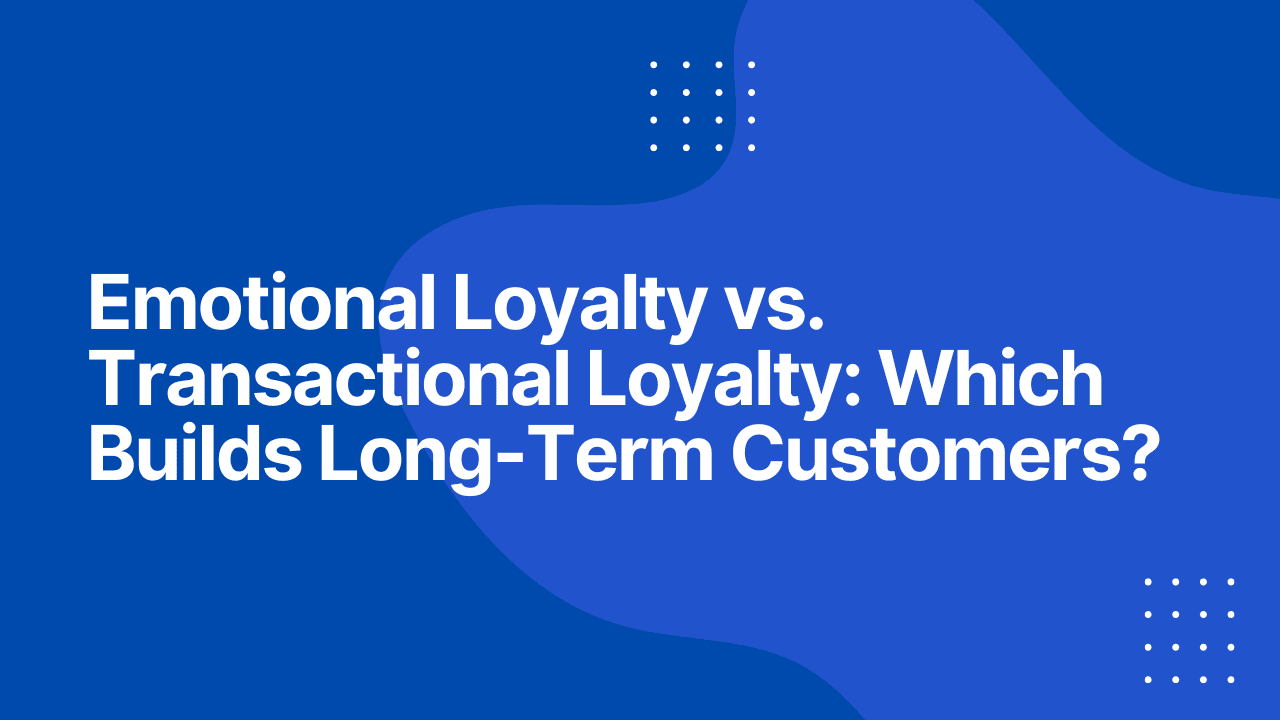Emotional Loyalty vs. Transactional Loyalty: Which Builds Long-Term Customers?

Introduction
Loyalty isn’t just about points, rewards, or discounts — it’s about connection.
While many brands focus on transactional loyalty (buy more, earn more), the strongest customer relationships are built on something deeper: emotional loyalty.
But what’s the real difference? And which one leads to long-term customer retention and higher lifetime value (CLTV)?
Let’s explore emotional vs. transactional loyalty — and how to use both to create loyal, engaged customers that stick around.
What Is Transactional Loyalty?
Transactional loyalty is based on rewards tied to spending or action. It’s performance-driven: customers stay loyal because they get something in return.
Examples:
- Earning points for every purchase
- Getting discounts or cashback
- Free shipping after a minimum spend
- Tier-based programs (Bronze, Silver, Gold)
Why It Works:
- Easy to launch and scale
- Drives short-term retention
- Appeals to price-conscious customers
Why It’s Limited:
- Loyalty is shallow — customers will leave for a better deal
- Often creates “discount dependence”
- Hard to differentiate from competitors
What Is Emotional Loyalty?
Emotional loyalty goes beyond incentives. It’s about creating meaningful connections and brand alignment. Customers feel attached to the brand — not just the deal.
Examples:
- Customers identify with your brand mission or values
- They share your content without asking
- They refer friends organically
- They feel “seen” by your personalization, community, or tone
Why It Works:
- Builds deeper, long-term loyalty
- Increases word-of-mouth and advocacy
- Customers forgive mistakes and stay longer
- Drives higher CLTV and retention over time
Why It’s Harder:
- Takes more time and strategy to build
- Harder to measure directly
- Requires authenticity and consistency across every touchpoint
Emotional vs. Transactional Loyalty: Key Differences
| Feature | Transactional Loyalty | Emotional Loyalty |
|---|---|---|
| Based On | Rewards, offers, discounts | Connection, trust, alignment |
| Time to Build | Fast | Slow but long-lasting |
| Customer Behavior | Repeat purchases for perks | Repeat + advocacy out of love |
| Churn Risk | High if better offer appears | Lower due to emotional tie |
| Example Brands | Starbucks Rewards, Sephora Beauty Insider | Apple, Patagonia, Glossier |
Which One Builds Stronger Customer Bonds?
The truth? Emotional loyalty creates deeper, more durable relationships.
- Buy more frequently
- Spend more over time
- Stay even if prices rise
- Recommend you enthusiastically
- Forgive small missteps
That said — you shouldn’t ignore transactional loyalty. It’s a great way to attract new buyers and kick-start the retention cycle.
How to Combine Both for Maximum Impact
The smartest brands use both types of loyalty in their strategy.
Here’s how to layer them:
- Start with a transactional loyalty program: Points, tiers, and rewards bring customers back.
- Build emotional connection over time: Through storytelling, personalization, and community engagement.
- Move from “buy again” to “belong here”: Make your brand feel like a lifestyle, not just a product.
Tactics to Build Emotional Loyalty
- Share your brand story and values clearly
- Build a community around your product (e.g., private groups, events)
- Celebrate customer milestones (birthdays, anniversaries)
- Feature user-generated content (UGC)
- Personalize every interaction — not just by name, but by behavior
- Support a cause your audience cares about
Tool tip: Loyalty platforms like Ziovy let you combine transactional rewards with emotion-driven campaigns like referrals, feedback loops, and VIP treatment.
What This Means for CLTV & Retention
By focusing on emotional loyalty, you move beyond one-time rewards and create customers who:
- Stay longer
- Spend more
- Refer friends
- Defend your brand publicly
In other words — they’re not just customers, they’re advocates.
Conclusion
Loyalty is no longer a one-size-fits-all solution. In a world flooded with offers, emotional connection is your competitive edge.
So yes — start with rewards. But don’t stop there. Build belonging. Spark emotion. Make your customers feel like part of something bigger than a purchase.
Because the strongest loyalty isn’t earned with points — it’s built with purpose.